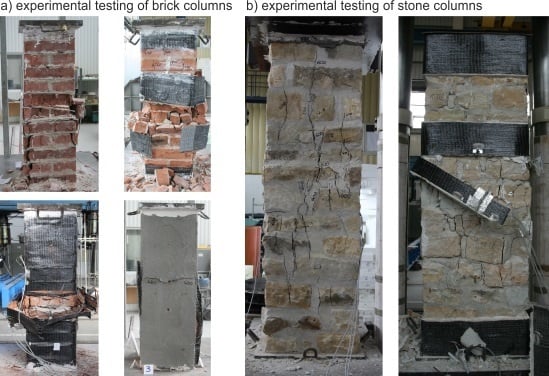Stress State Analysis and Failure Mechanisms of Masonry Columns Reinforced with FRP under Concentric Compressive Load
Abstract
:1. Introduction
2. Numerical Analysis and Experimental Verification of Failure Mechanisms in Compressed Masonry Columns
2.1. Failure Mechanism of Brick and Stone Masonry Columns under Concentric Compressive Load
- The masonry failure process under concentric compressive load—its failure mechanism and a gradual loss in its ability to transfer loads—occurs in one or two phases with a different failure mechanism seen in each of these phases.
- In the phase when cracks appear and develop (phase I), failure due to “tension and shear” mostly applies (cracks arise in the direction of the principal compressive stress). In the second phase of progressive development and expansion of cracks (phase II), it is masonry failure due to “compression” that applies. In the case of unreinforced or weakly (“ineffectively”) reinforced concentrically compressed masonry structures with different masonry unit and binder properties, the failure mechanism solely or largely includes phase I. The appearance and development of vertical tensile and shear cracks precedes the ultimate load of masonry in compression being reached and is accompanied by the disruption of the integrity (rupture) of the column due to the effect of transverse tensile forces (Figure 11).
- During the initial phase I, when tensile and shear cracks running in the direction of compression trajectories arise and gradually develop throughout the masonry, redistribution and non-uniform distribution of compressive normal stresses in the horizontal cross sections of masonry appear. The transverse (horizontal) tensile (or shear) stresses cause gradual “subdivision” of the column into individual parts defined by vertically running tensile and shear cracks. During this process, the tensile strength of masonry units primarily applies (Figure 12).
2.2. Failure Mechanism of FRP Reinforced Columns
- In the case of masonry columns weakly (“insufficiently”) reinforced with partial non-pre-stressed fabric-based composite wrapping strips, the gradual propagation and development process of tensile and shear cracks in the column masonry (phase I) is accompanied by a gradual growth in tensile stresses in this composite due to the effect of “expanding” masonry. Horizontal transverse displacement of masonry is caused by transverse stresses due to the effect of masonry contraction and the effect of mutual interaction between masonry units and the bed joint filler. Despite the growing horizontal and vertical displacements δx and δy, the masonry column is still able to transfer the growing compressive load due to its reinforcement (stabilization) with discrete passive wrapping in a composite that takes up part of the tensile stresses (Figure 14 and Figure 15).
- After tensile crack appearance (in the order of 10−1 mm and bigger), there is progressive growth in horizontal strains εx, the propagation and development of tensile cracks, which become the major agents in the failure of masonry structures under compressive load. The initial value of the εx/εy ratio in unreinforced columns in the phase preceding the appearance of the first (hairline) cracks lies in the interval of 0.05 to 0.1. When ultimate load in concentric compression is reached, the value of the εx/εy ratio in unreinforced columns lies in the interval of 0.35 to 0.8, while in the case of columns reinforced with carbon fiber composites lies in the interval of 1.0 to 1.8 (Figure 16).
- In the case of concentrically compressed masonry columns effectively reinforced (strengthened) with a composite based on high-strength fibers and epoxy resin (which takes up part of the transverse tensile forces in the masonry due to the effect of the forced masonry displacement), the failure mode corresponding to phase II applies during the stage when the ultimate load in compression is approached and reached. In this phase of column masonry failure, the compressive strength of the masonry units applies to a greater extent. Attainment of ultimate load is accompanied by the disintegration and crushing of the masonry units and the bed joint filler and, successively, by the total failure (disintegration) of the masonry.
- Masonry failure due to the exhaustion of masonry unit compressive strength was observed, for example, in coursed masonry stonework columns with irregular masonry units and thin bed joints (ca. 12–15 mm), and in brickwork or stonework columns with effective wrapping in carbon fabric composites during the experimental research. Figure 17 displays the characteristic failure mode of masonry units and the bed joint filler due to tensile cracks and crushing. It is the consequence of efficient interaction between the carbon fabric wrapping and masonry during the phase of active vertical tensile crack development in the column masonry and the partial failure and disintegration of masonry units (phase I and phase II).
- In phase II, the adhesive bond in the contact joint between the carbon fabric and masonry usually fails, with the carbon fabric’s reaction to the column masonry’s forced displacement exerted by growing horizontal displacements concentrated in the areas close to the column’s edges. First, perimeter parts of the column loaded with biaxial stress states are damaged—separated by tensile cracks. In the central part of the masonry cross section exposed to stress states by triaxial compression/tension, the masonry completely disintegrates (mainly the masonry units). In this failure mechanism, the compressive strength of individual components (mainly masonry units) primarily applies. This failure mechanism mainly applies in cases with effective wrapping of a masonry column—overall wrapping or wrapping in strips optimally distributed along the column’s length. With increasing distance between and lower height of carbon fabric wrapping strips, as well as lower efficiency of wrapping strips in which lower ultimate load values in concentric compression are reached, the failure mechanism occurring during the first phase (column failure due to vertical tensile cracks) predominantly applies.
2.3. Passive FRP Wrapping Efficiency
- In the case of “optimum” reinforcement of a masonry column with composite strips, i.e., with a distance between strips smaller than or equal to no more than 1.5 times the composite strip height, there was an increase in vertical displacements δy to 247%, horizontal displacements δx to 742%, and ultimate load to 136% compared to the values reached for unreinforced masonry columns.
- In the case of overall wrapping of a masonry column in carbon composites, where the failure mechanism (corresponding to phase II) prior to reaching the ultimate load may be assumed, the growth in vertical displacements δy amounted to 161%, horizontal displacements δx 400%, and ultimate load 179%, compared to the values for unreinforced masonry columns.
- The experimental research into masonry columns damaged (before reinforcement) by tensile cracks up to (<1.5 mm) in width and extending to ca. 30%–40% of the column’s height and then additionally reinforced with FRP composites, pointed out the possibility of achieving the comparable mechanical and strain characteristics of identically reinforced undamaged masonry columns (without the initial cracks) through this additional reinforcement (Figure 18). This is particularly evident in phase I of the columns failure. In this phase, the transverse wrapping of a masonry column in composites with high load-bearing capacity is relevant and the effect of overall column reinforcement is especially dramatic (Figure 19). This finding agrees with the “composite–masonry” interaction pattern during which the composite is activated with effect only during the phase when tensile cracks develop (10−1 mm and bigger).
- The passive wrapping of column masonry damaged by tensile and shear cracks in non-pre-stressed fabrics made from high-strength fibers represents an efficient stabilization means by preventing further propagation and development of cracks, and securing the structural function of masonry damaged by tensile cracks.
- The effectiveness of column masonry passive wrapping in a carbon fiber composite depends on the extent of damage to individual columns and must be assessed separately for each case of masonry failure.
- The predominantly positive effect on stress states in triaxial compression of mortar in bed joints in brick masonry after passive wrapping cannot be applied to irregular stone or mixed masonry comprising irregular, roughly dressed masonry blocks with fragments and sharp-edged, undressed, quarry stone masonry units. Here, cracking and masonry damage occur in areas where local stress states with extreme stress values (σx, σy, τxy) arise, e.g., around the masonry layout of irregular, sharp-edged units with a relatively higher modulus of elasticity than the surrounding relatively more yielding binder (Figure 20). These effects are usually unfavorably manifested, mainly at higher masonry loading values in compression (under loads exceeding 60% of ultimate load). As a consequence, these effects reduce the ultimate strength of stone masonry in compression (Figure 21).
- A special category is represented by compressed masonry columns in which, due to the properties and shape of masonry units, their binder and layout (regular masonry units with identical mechanical properties, thin bed joints with a filler of approximately the same mechanical characteristics as those of the masonry units), no transverse tensile forces that usually compensate the tendency of individual masonry layers towards different transverse displacements under concentric compressive load arise. In these reinforced masonry columns, the transverse displacement of masonry loaded by compressive forces is caused solely by contraction. The effectiveness of passive wrapping of column masonry in these cases is significantly lower compared to coursed masonry with quarry stone blocks (Figure 22).
2.4. Ultimate Strength of Masonry Reinforced with Composites under Concentric Compressive Load
- In the case of columns of regular, coursed rubble masonry with dressed stone and thin bed joints reinforced by composite strips, the experimental research demonstrated that the tensile “capacity” of the composite was not efficiently exploited and, due to this, their ultimate load does not significantly increase. In the case of the above masonry, transverse displacements and forced transverse stresses due to the effect of passive wrapping are relatively very low as a consequence of the “mortar bed–masonry unit” lower intensity interaction.
- The ultimate load of a reinforced stonework column under concentric compressive load hardly differs from the ultimate load of an unreinforced column (see Figure 22). The failure occurs by reaching the ultimate displacement and strain of stone masonry in compression δym accompanied by the local failure of masonry in compression—crushing and disintegration of masonry units and the binder. The experimentally measured, relatively low horizontal displacements δxm also agree with the failure mechanism of stonework columns with regular, dressed blocks and coursed masonry (phase II). This fact must be considered when calculating the compressive strength of stone masonry reinforced with FRP fabrics, in which the above described failure mechanism under compressive loading applies. Also, the relatively slight effect achieved by wrapping a column in fabrics of high-strength carbon or glass fibers may be objectively assumed.
- In the case of coursed or irregular stone masonry (column) with undressed or roughly dressed stone blocks and larger bed joints (>20–25 mm) under concentric compressive load, the application of the failure mechanism characterized by the appearance and development of tensile cracks running approximately in the direction of compression trajectories—phase I—may be assumed. It is usually accompanied by the gradual growth in transverse horizontal displacements δx in stone column masonry, together with a significant redistribution of compressive loading over the masonry cross section. In the case of an efficient “masonry–fabric (composite)” interaction, the ultimate load of stone masonry in compression dramatically rises compared to the ultimate load of unreinforced stone masonry (Figure 23) due to the effect of reinforcement by fabrics applied as wrapping bands (EBR) to the masonry or as strips inserted into horizontal joints (NSM).
3. Conclusions
Acknowledgments
Author Contributions
Conflicts of Interest
References
- Saadatmanesh, H. Extending service life of concrete and masonry structures with fiber composites. Constr. Build. Mater. 1997, 11, 327–335. [Google Scholar] [CrossRef]
- Doran, B.; Koksal, H.O.; Turgay, T. Nonlinear finite element modeling of rectangular/square concrete columns confined with FRP. Mater. Des. 2009, 30, 3066–3075. [Google Scholar] [CrossRef]
- Wu, Y.F.; Jiang, C. Effect of load eccentricity on the stress–strain relationship of FRP-confined concrete columns. Compos. Struct. 2012, 98, 228–241. [Google Scholar] [CrossRef]
- Corradi, M.; Borri, A.; Vignoli, A. Strengthening techniques tested on masonry structures struck by the Umbrian-Marche earthquake of 1997–1998. Constr. Build. Mater. 2002, 16, 229–239. [Google Scholar] [CrossRef]
- Zhao, T.; Zhang, C.J.; Xie, J. Experimental study on earthquake strengthening of brick walls with continuous carbon fiber sheet. Mason. Int. 2003, 16, 21–25. [Google Scholar]
- Shrive, N.G. The use of fiber reinforced polymers to improve seismic resistance of masonry. Constr. Build. Mater. 2006, 20, 269–277. [Google Scholar] [CrossRef]
- Eslami, A.; Ronagh, H.R. Effect of FRP wrapping in seismic performance of RC buildings with and without special detailing—A case study. Compos. Part B 2013, 45, 1265–1274. [Google Scholar] [CrossRef]
- Bruggi, M.; Milani, G.; Taliercio, A. Design of the optimal fiber-reinforcement for masonry structures via topology optimization. Int. J. Solids Struct. 2013, 50, 2087–2106. [Google Scholar] [CrossRef]
- Luccioni, B.; Rougier, V.C. In-plane retrofitting of masonry panels with fiber reinforced composite materials. Constr. Build. Mater. 2011, 25, 1772–1788. [Google Scholar] [CrossRef]
- Grande, E.; Imbimbo, M.; Sacco, E. Finite element analysis of masonry panels strengthened with FRPs. Compos. Part B 2013, 45, 1296–1309. [Google Scholar] [CrossRef]
- Corradi, M.; Grazini, A.; Borri, A. Confinement of brick masonry columns with CFRP materials. Compos. Sci. Technol. 2007, 67, 1772–1783. [Google Scholar] [CrossRef]
- Faella, C.; Martinelli, E.; Paciello, S.; Camorani, G.; Aiello, M.A.; Micelli, F.; Nigro, E. Masonry columns confined by composite materials: Experimental investigation. Compos. Part B 2011, 42, 692–704. [Google Scholar] [CrossRef]
- Krevaikas, T.D.; Triantafillou, T. Masonry confinement with fiber-reinforced polymers. J. Compos. Constr. 2005, 9, 128–135. [Google Scholar] [CrossRef]
- Micelli, F.; de Lorenzis, L.; La Tegola, A. FRP-confined masonry columns under axial loads: Analytical model and experimental results. Mason. Int. J. 2004, 17, 95–108. [Google Scholar]
- Aiello, M.A.; Micelli, F.; Valente, L. Structural upgrading of masonry columns by using composite reinforcements. J. Compos. Constr. 2007, 11, 650–658. [Google Scholar] [CrossRef]
- Marcari, G.; Oliveira, D.V.; Fabbrocino, G.; Lourenço, P.B. Shear capacity assessment of tuff panels strengthened with FRP diagonal layout. Compos. Part B 2011, 42, 1956–1965. [Google Scholar] [CrossRef] [Green Version]
- Di Ludovico, M.; D’Ambra, C.; Prota, A.; Manfredi, G. FRP confinement of tuff and clay brick columns: experimental study and assessment of analytical models. ASCE J. Compos. Constr. 2010, 14, 583–596. [Google Scholar] [CrossRef]
- Micelli, F.; Di Ludovico, M.; Balsamo, A.; Manfredi, G. Mechanical behavior of FRP-confined masonry by testing of full-scale columns. Mater. Struct. 2014, 47, 2081–2100. [Google Scholar] [CrossRef]
- Camli, U.S.; Binici, B. Strength of carbon fiber reinforced polymers bonded to concrete and masonry. Constr. Build. Mater. 2007, 21, 1431–1446. [Google Scholar] [CrossRef]
- Faella, C.; Camorani, G.; Martinelli, E.; Paciello, S.; Perri, F. Bond behavior of FRP strips glued on masonry: Experimental investigation and empirical formulation. Constr. Build. Mater. 2013, 31, 353–363. [Google Scholar] [CrossRef]
- Garbin, E.; Panizza, M.; Valluzzi, M.R. Experimental assessment of bond behavior of fiber-reinforced polymers on brick masonry. Struct. Eng. Int. 2010, 20, 392–399. [Google Scholar] [CrossRef]
- Carrara, P.; Ferretti, D.; Freddi, F. Debonding behavior of ancient masonry elements strengthened with CFRP sheets. Compos. Part B 2013, 45, 800–810. [Google Scholar] [CrossRef]
- Grande, E.; Imbimbo, M.; Sacco, E. Bond behavior of CFRP laminates glued on clay bricks: Experimental and numerical study. Compos. Part B 2011, 42, 330–340. [Google Scholar] [CrossRef]
- Fedele, R.; Milani, G. Three-dimensional effects induced by FRP-from-masonry delamination. Compos. Struct. 2011, 93, 1819–1831. [Google Scholar] [CrossRef]
- Capozucca, R. Experimental FRP/SRP–historic masonry delamination. Compos. Struct. 2010, 92, 891–903. [Google Scholar] [CrossRef]
- Capozucca, R. Effects of mortar layers in the delamination of GFRP bonded to historic masonry. Compos. Part B 2013, 44, 639–649. [Google Scholar] [CrossRef]
- Ghiassi, B.; Oliveira, D.V.; Lourenço, P.B.; Marcari, G. Numerical study of the role of mortar joints in the bond behavior of FRP-strengthened masonry. Compos. Part B 2013, 46, 21–30. [Google Scholar] [CrossRef]
- Kashyap, J.; Willis, C.R.; Griffith, M.C.; Inghamb, J.M.; Masia, M.J. Debonding resistance of FRP-to-clay brick masonry joints. Eng. Struct. 2012, 41, 186–198. [Google Scholar] [CrossRef]
- Kwiecien, A. Stiff and flexible adhesives bonding CFRP to masonry substrates—Investigated in pull-off test and Single-Lap test. Arch. Civ. Mech. Eng. 2012, 12, 228–239. [Google Scholar] [CrossRef]
- ČSN EN 1996–1-1 Eurocode 6: Design of Masonry Structures—Part 1–1: General Rules for Reinforced and Unreinforced Masonry Structures; Czech Office for Standards, Metrology and Testing (UNMZ): Prague, Czech Republic, 2013.
- ČSN 731101 Design of Masonry Structures (Change B); Czech Office for Standards, Metrology and Testing (UNMZ): Prague, Czech Republic, 2013.
- CNR-DT 200 R1/2013. Guide for the Design and Construction of Externally Bonded FRP Systems for Strengthening Existing Structures, Revision 1; Italian Council of Research (CNR): Rome, Italy, 2014. [Google Scholar]
- ISO 13822:2010 Bases for Design of Structures—Assessment of Existing Structures; International Organization for Standardization: Geneva, Switzerland, 2010.
- Abaqus Unified FEA—Simulia Package. Available online: https://www.3ds.com/fileadmin/PRODUCTS/SIMULIA/PDF/brochures/simulia-abaqus-unified-fea-brochure.pdf (accessed on 15 August 2015).
- FEAT2000, version 3; SMARTsoft s.r.o.: Prague, Czech Republic, 2000.
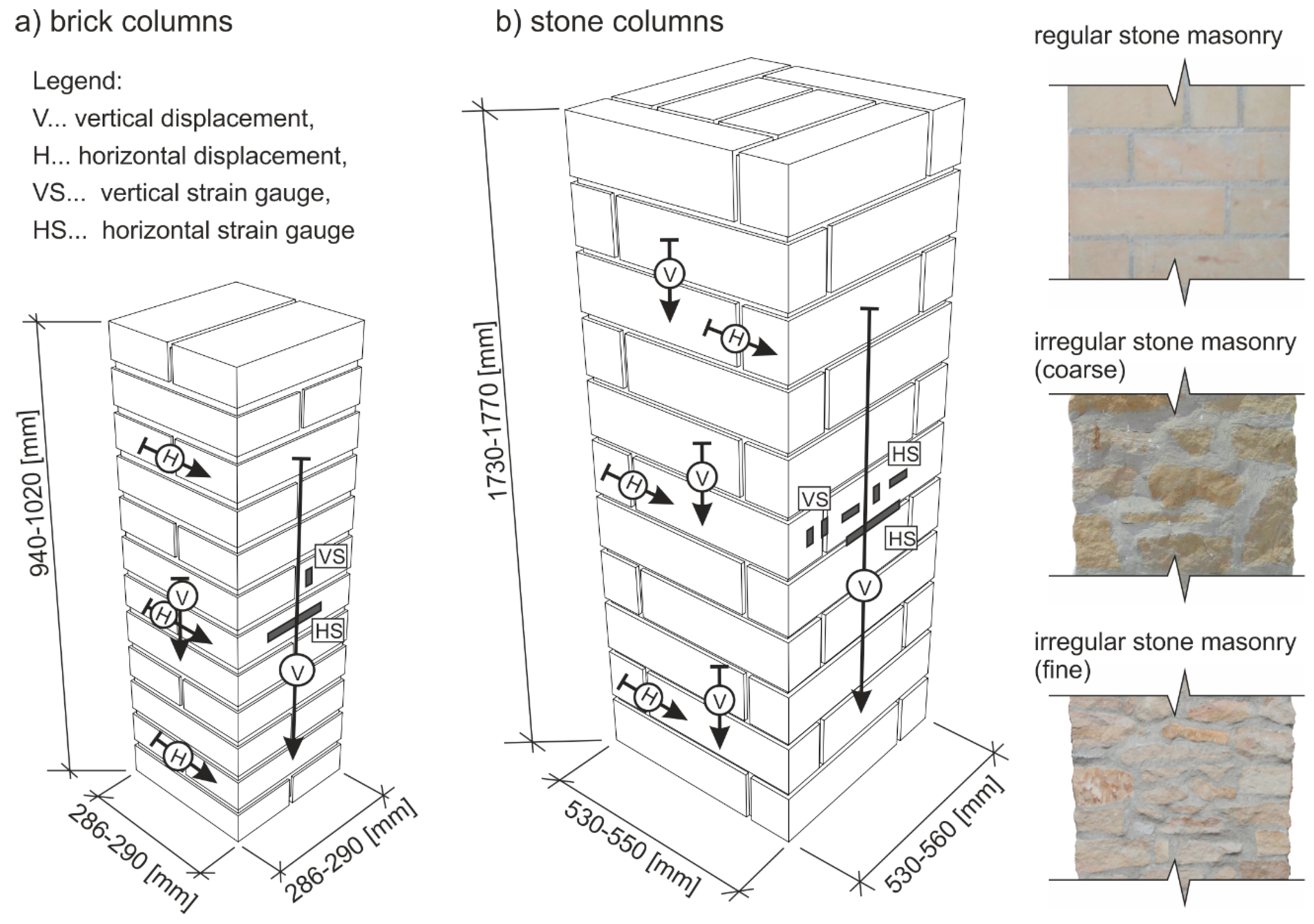
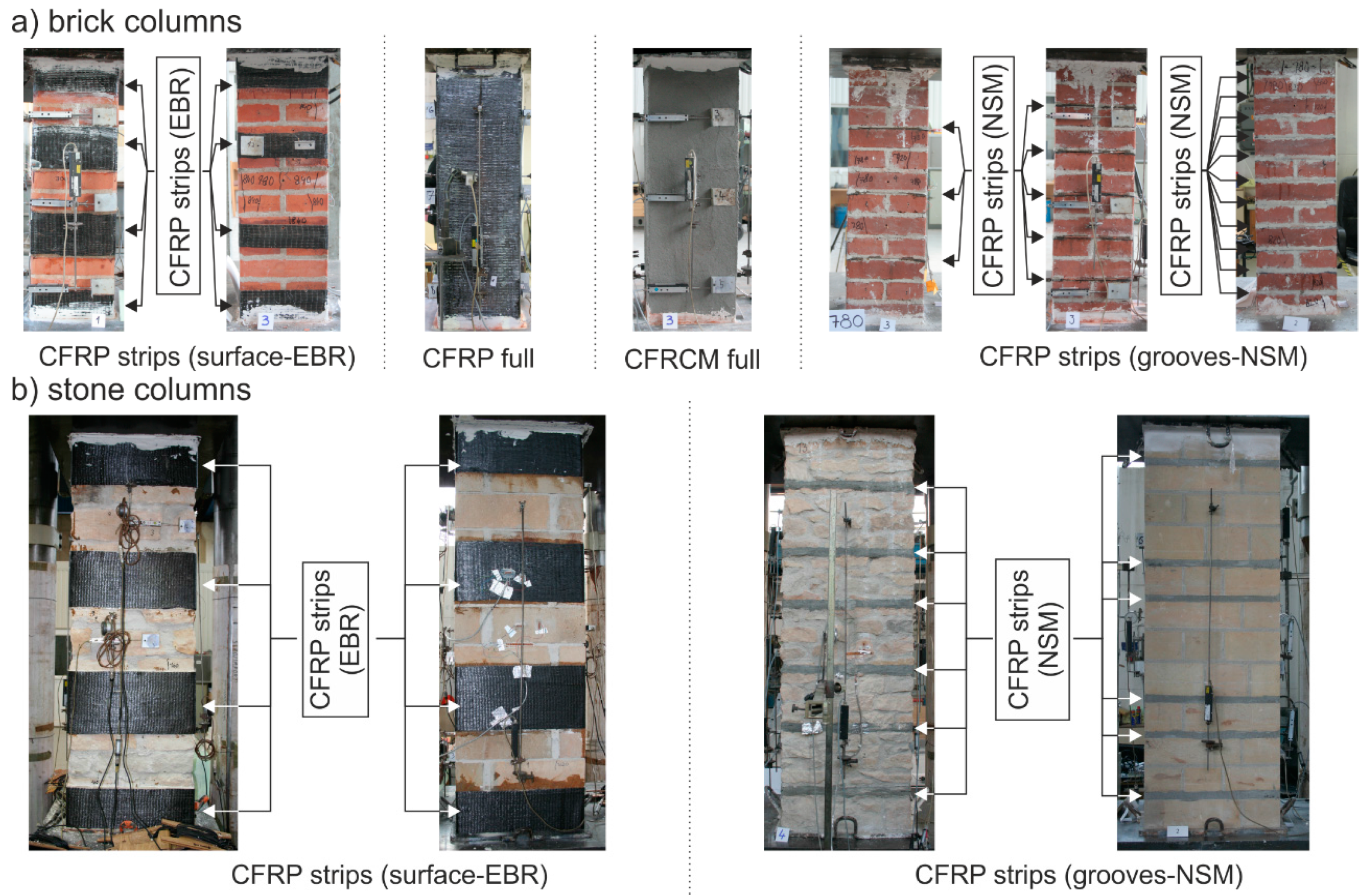
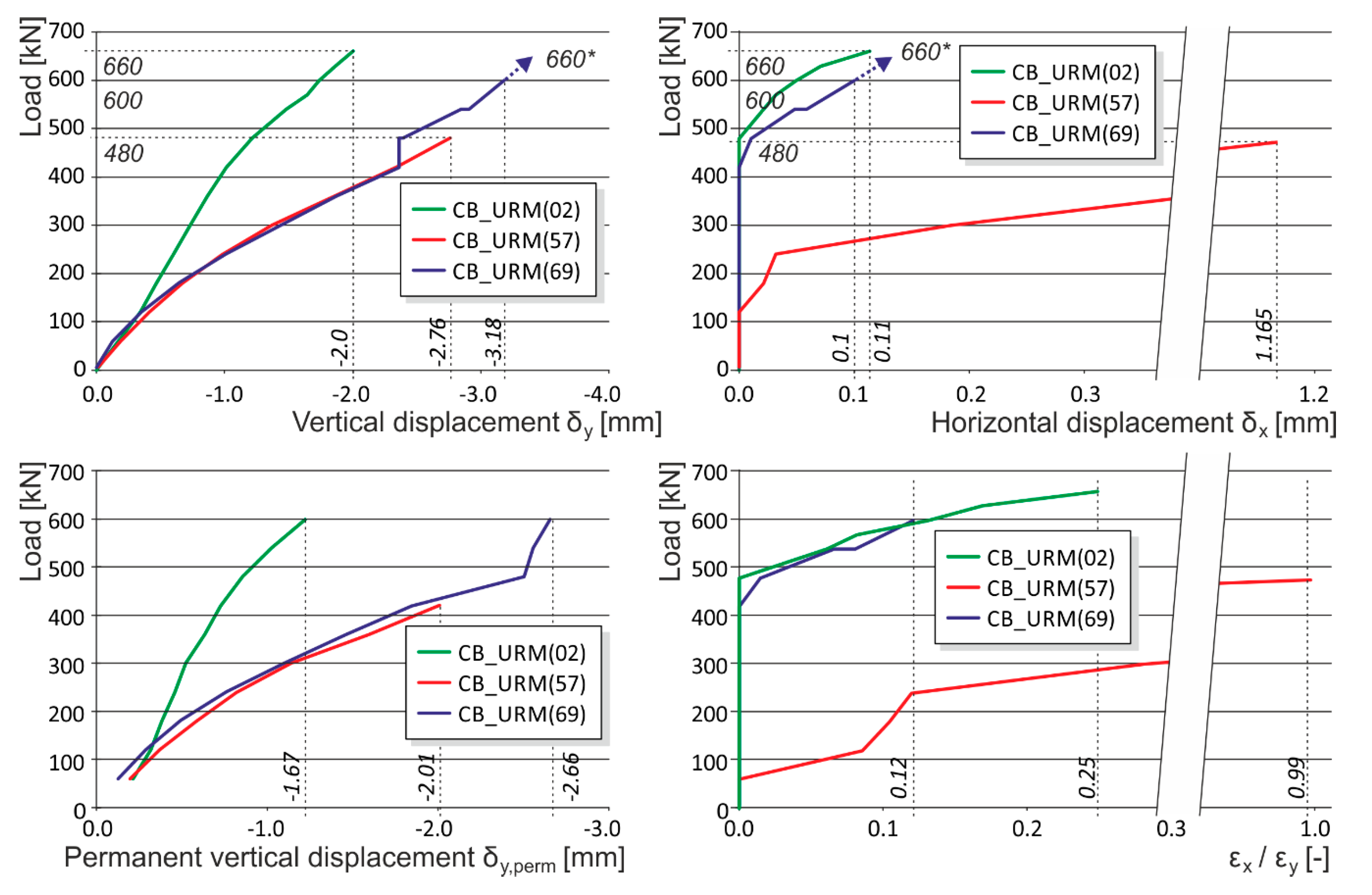
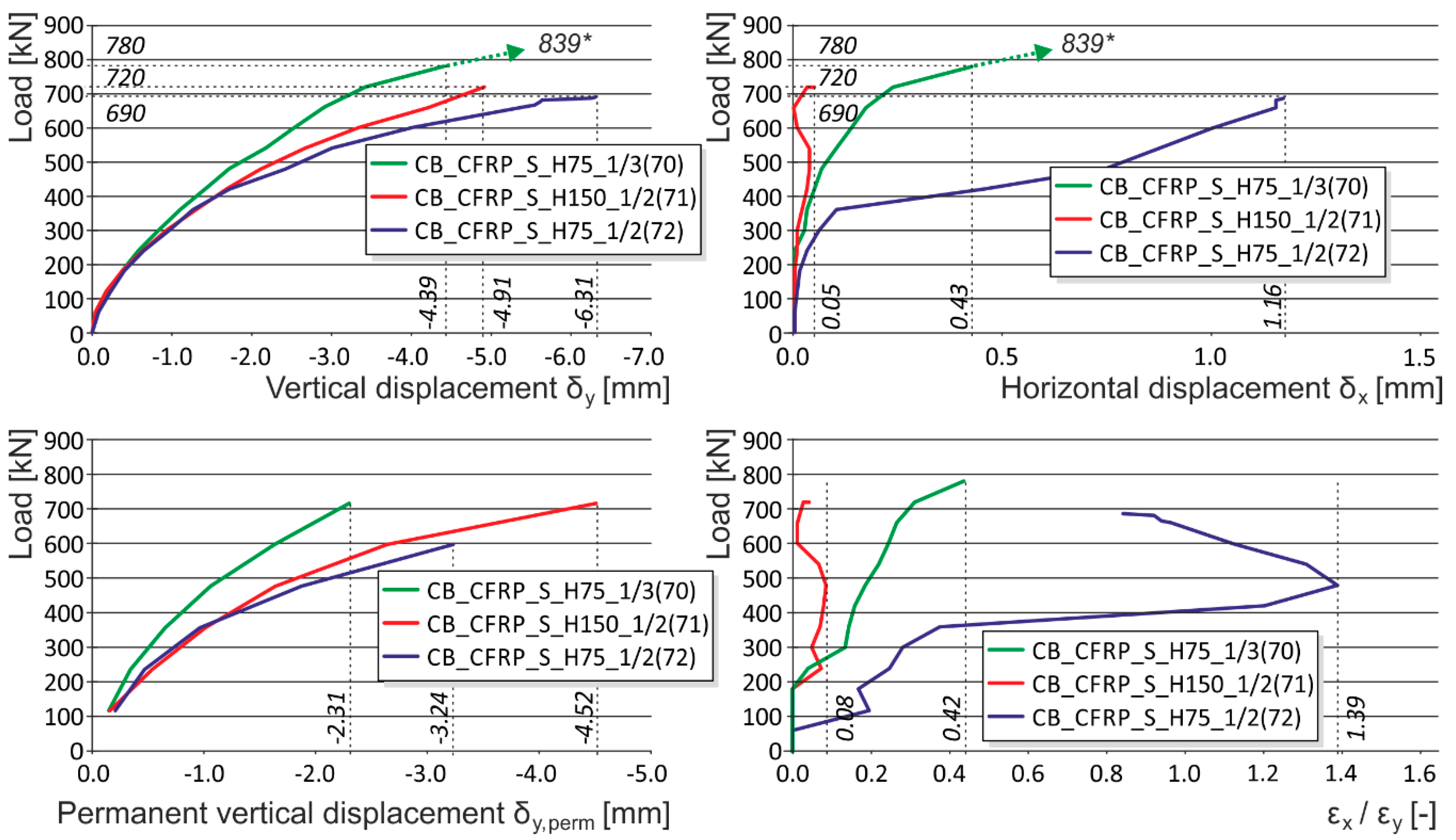
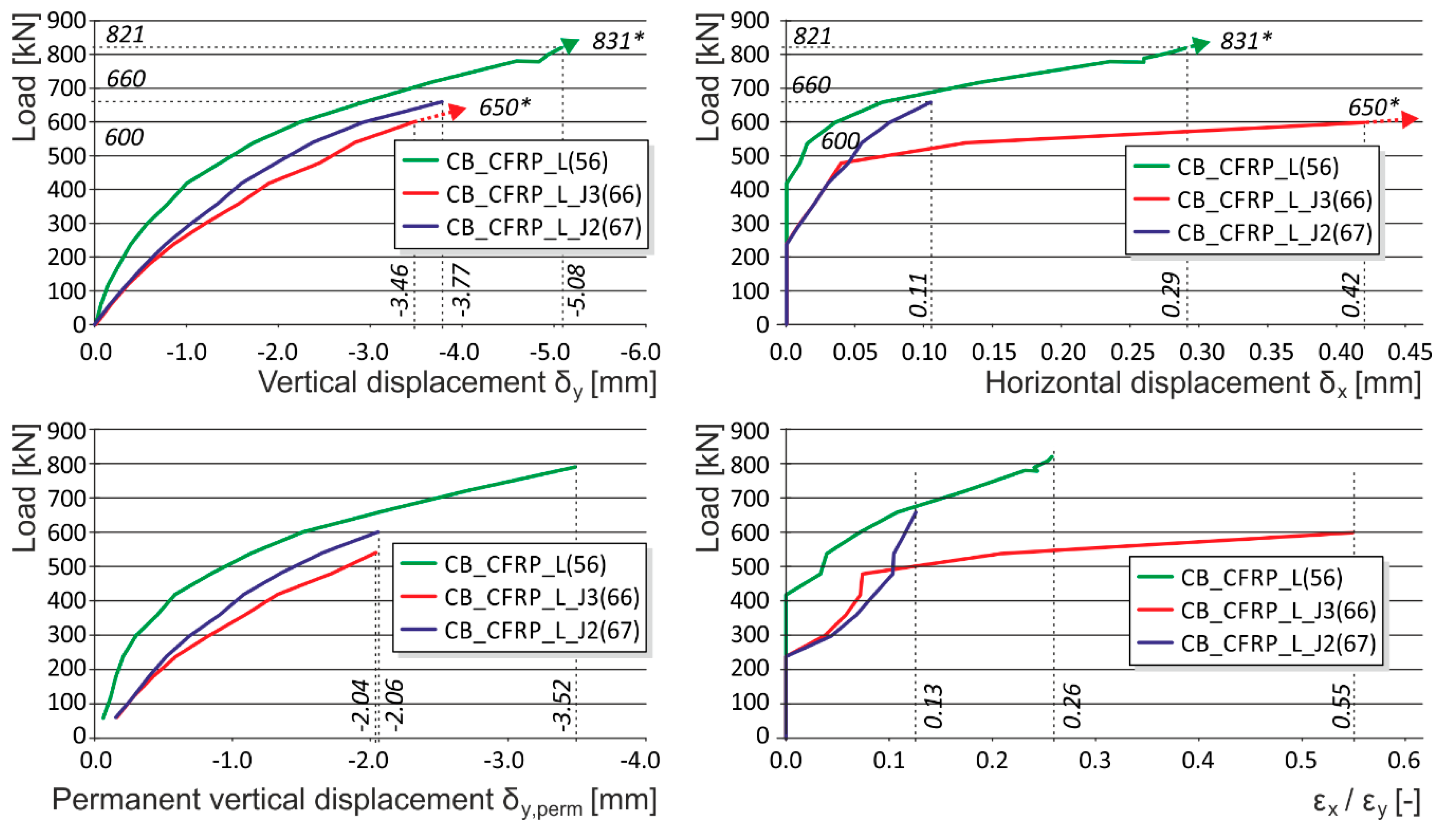
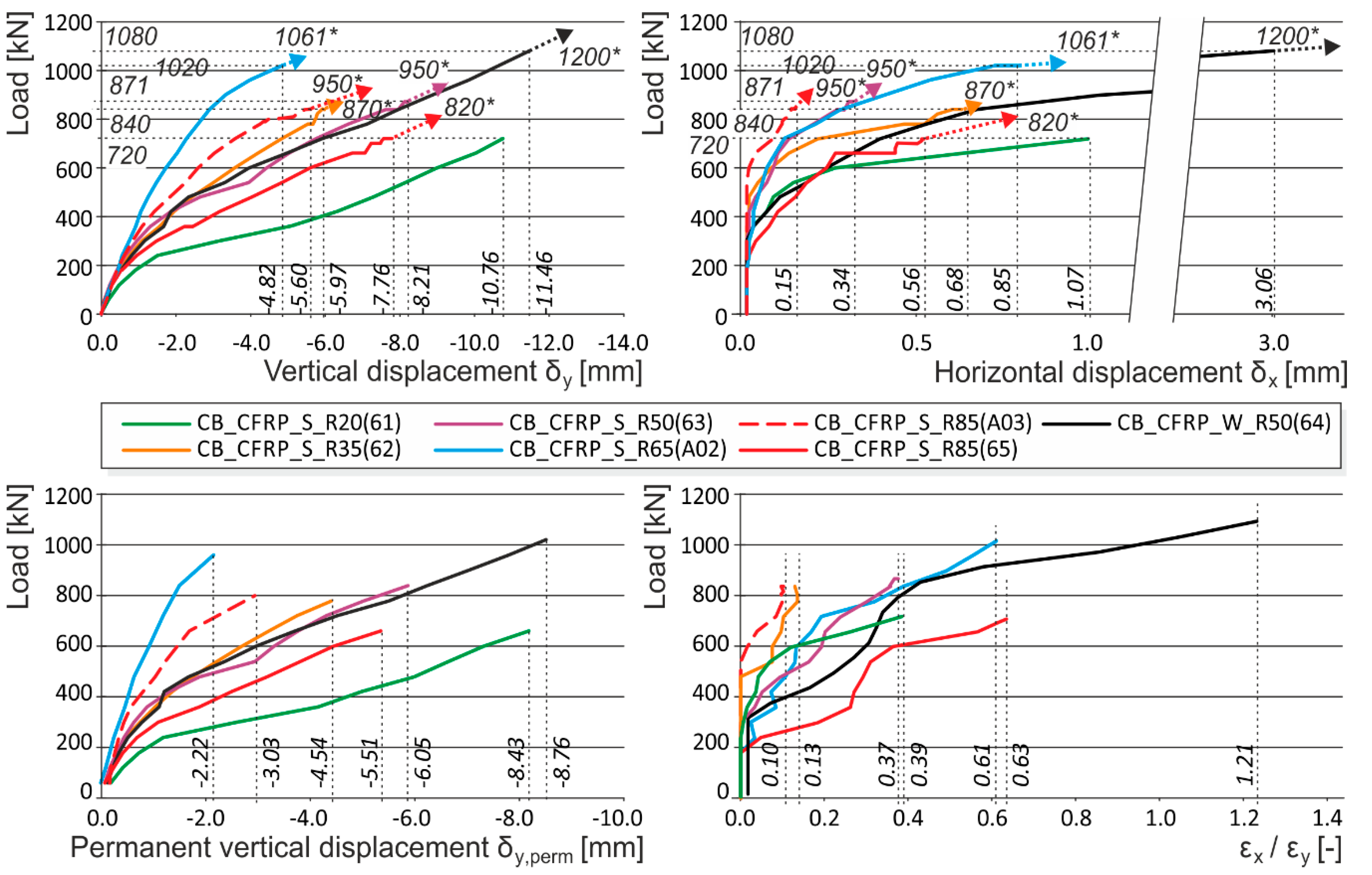
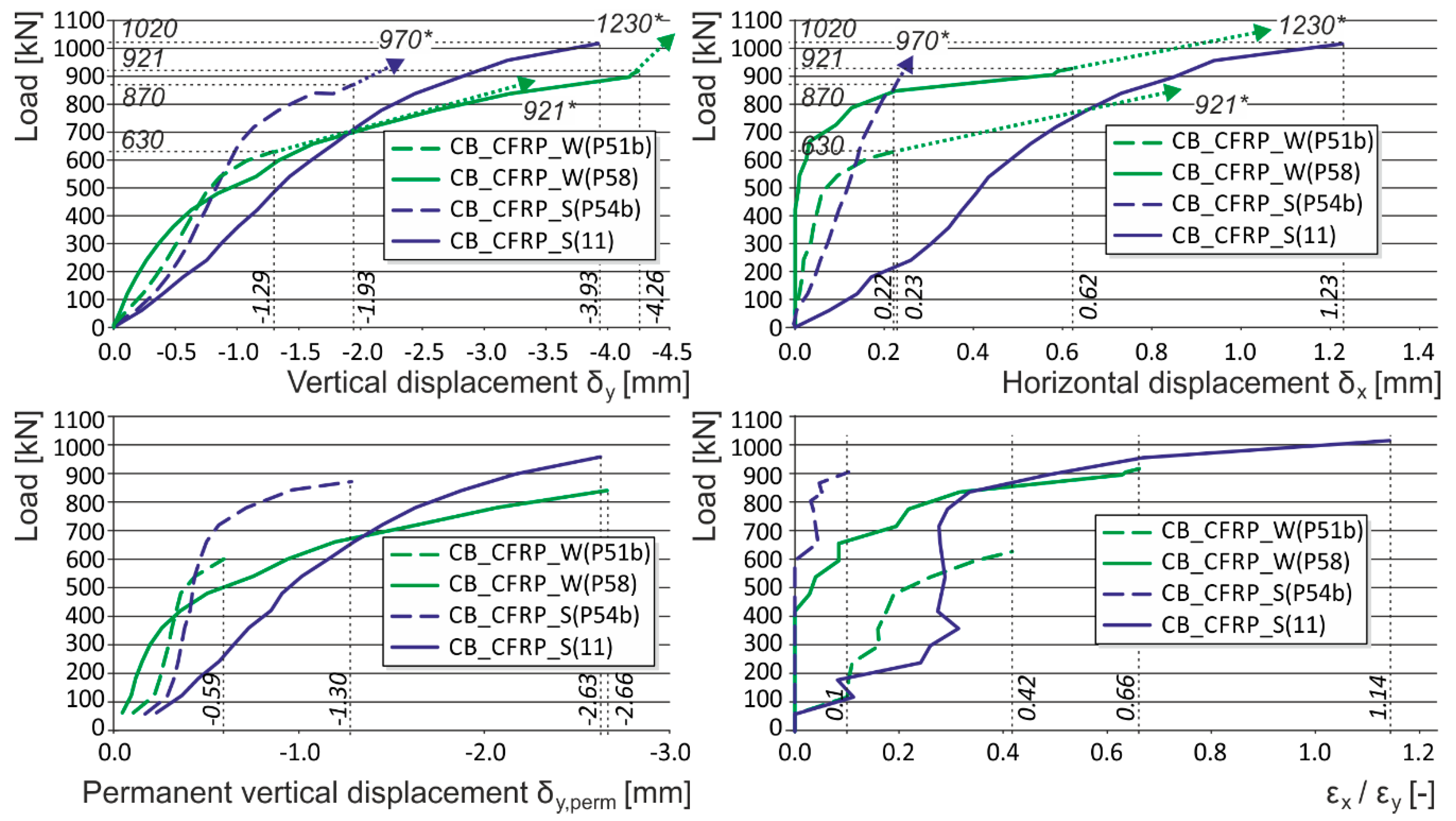
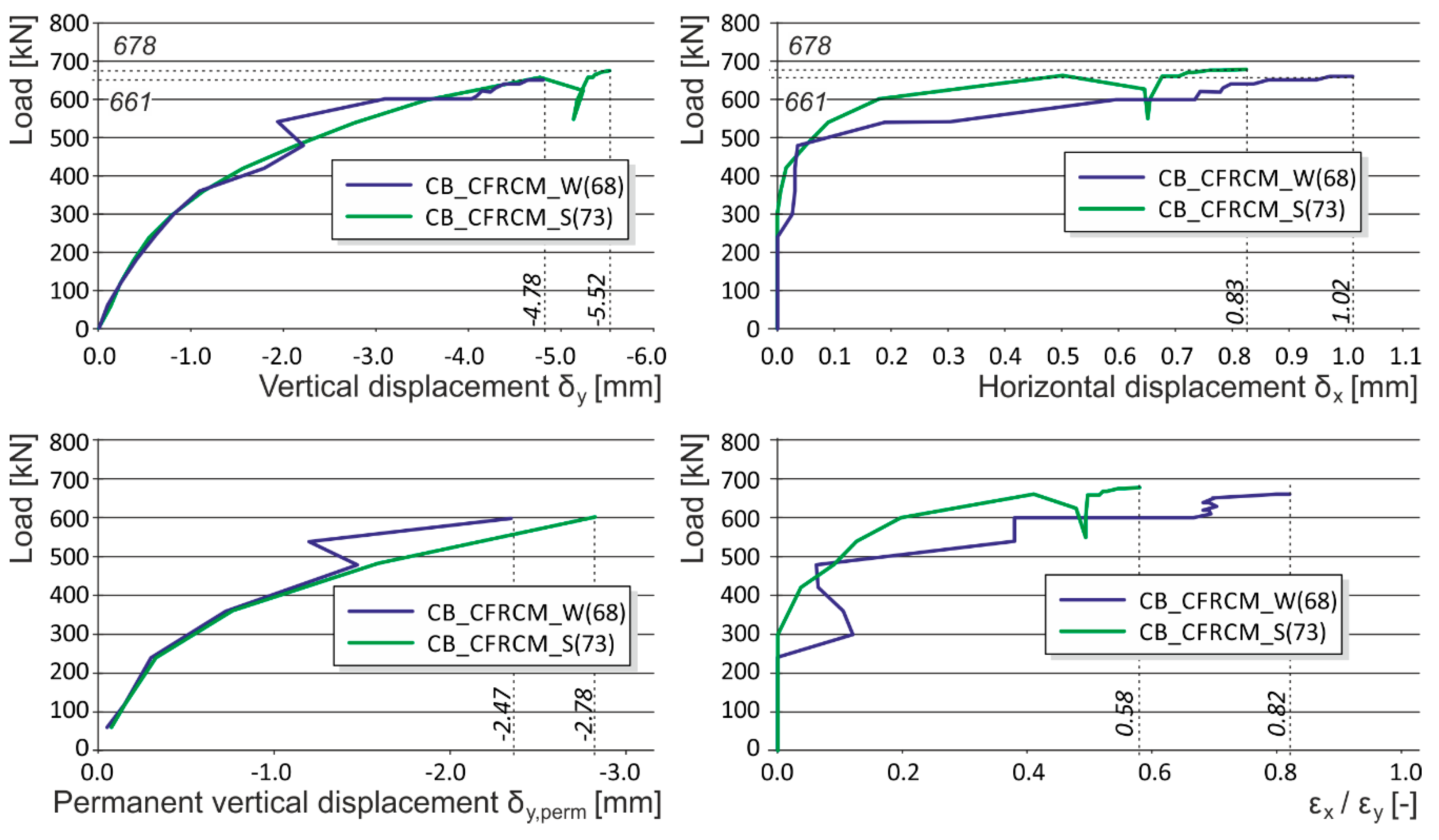

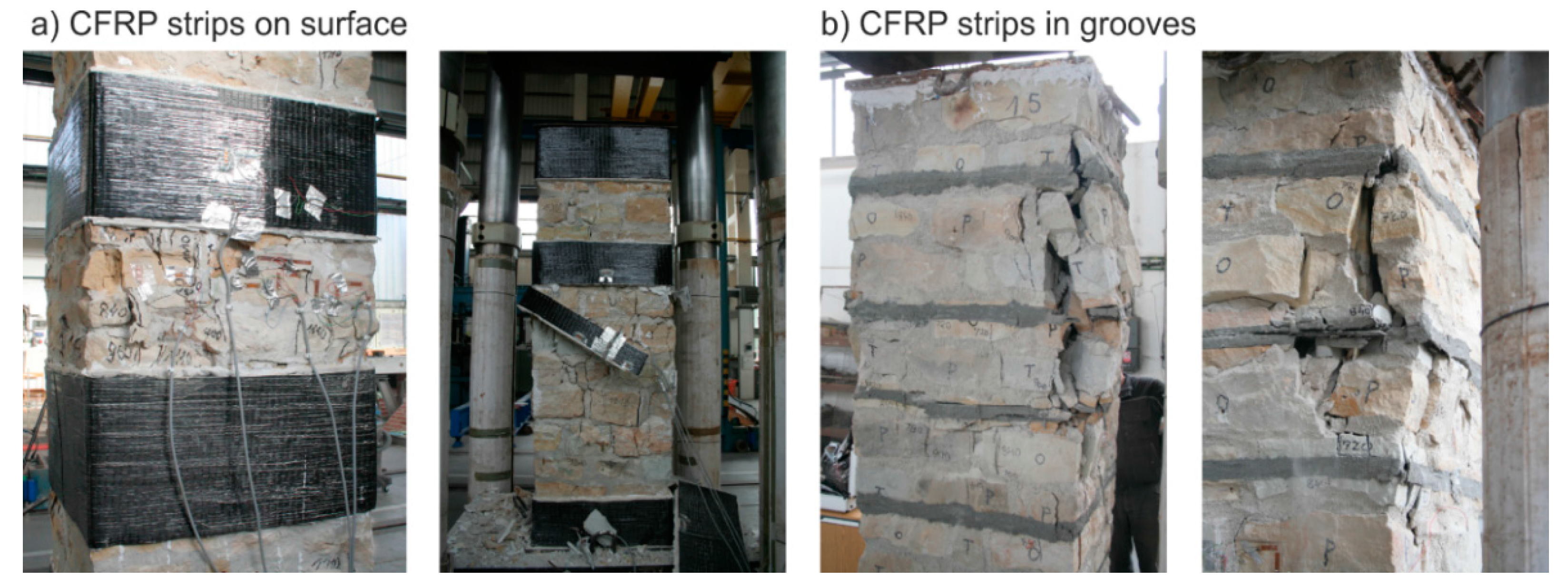
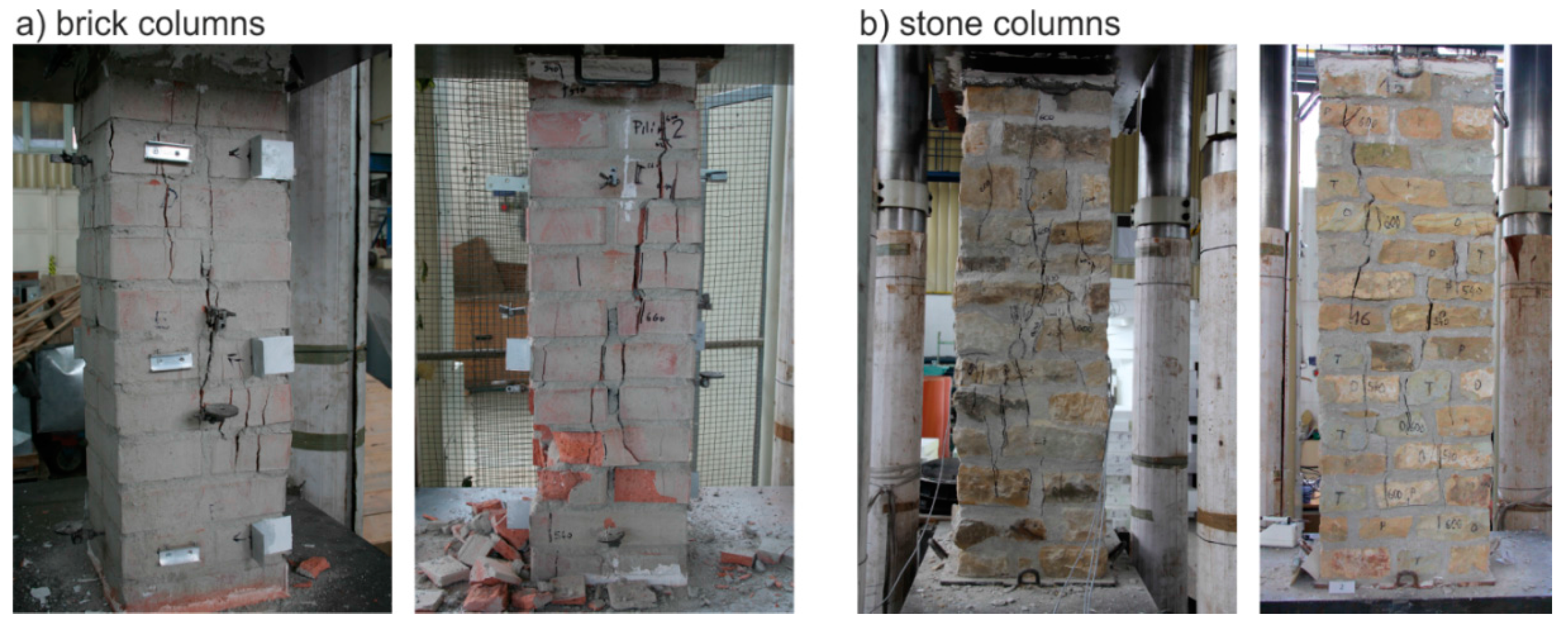

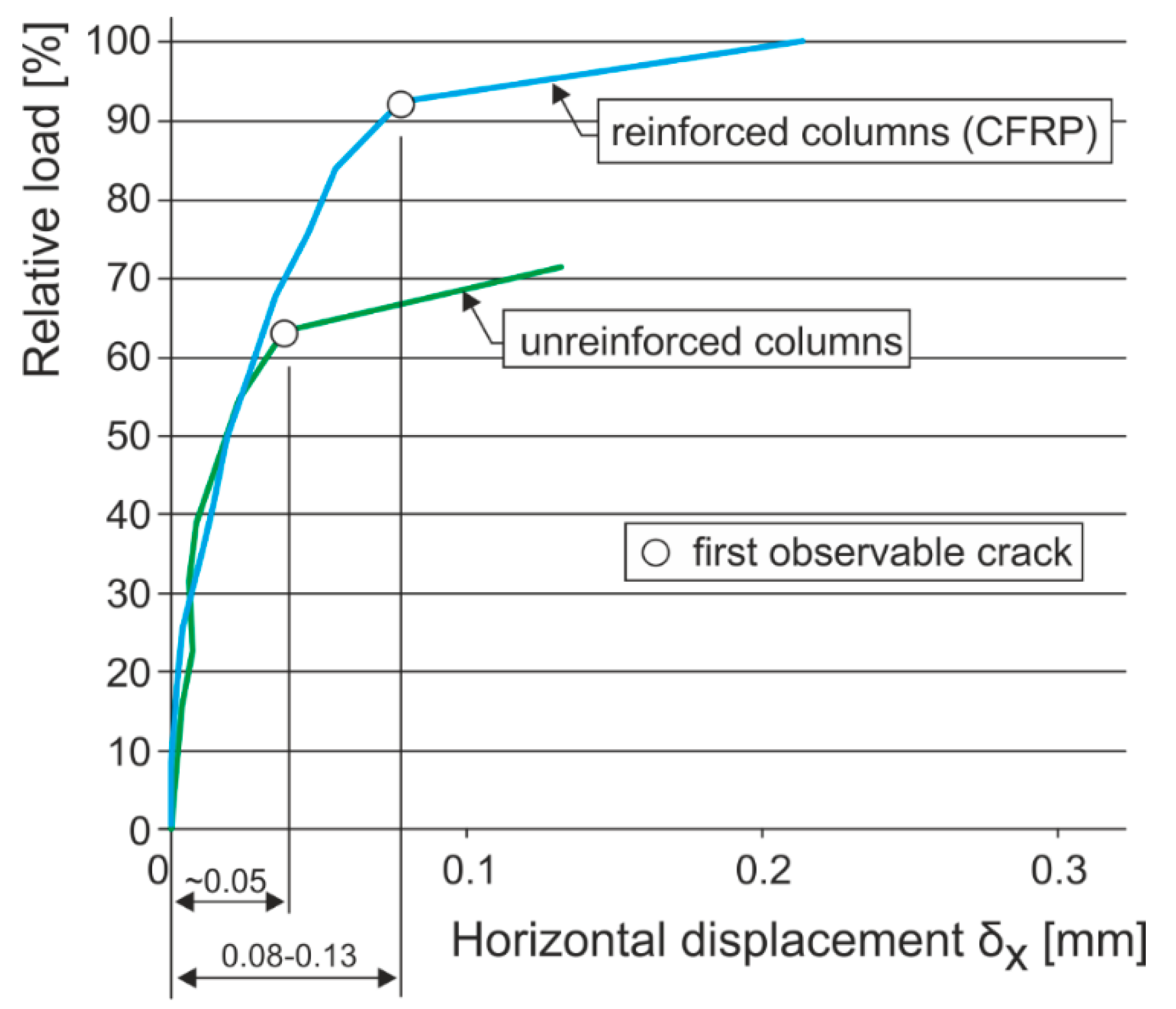
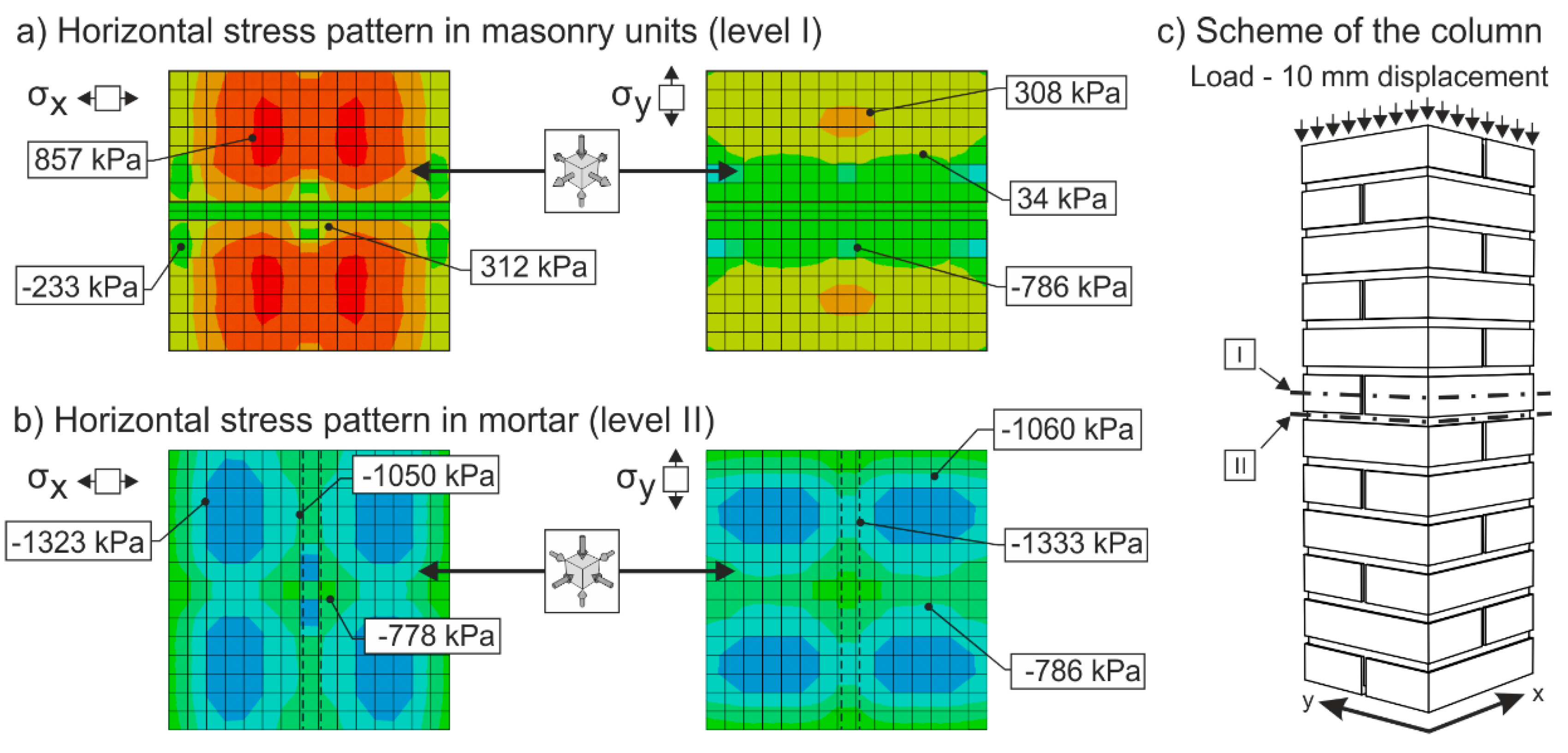
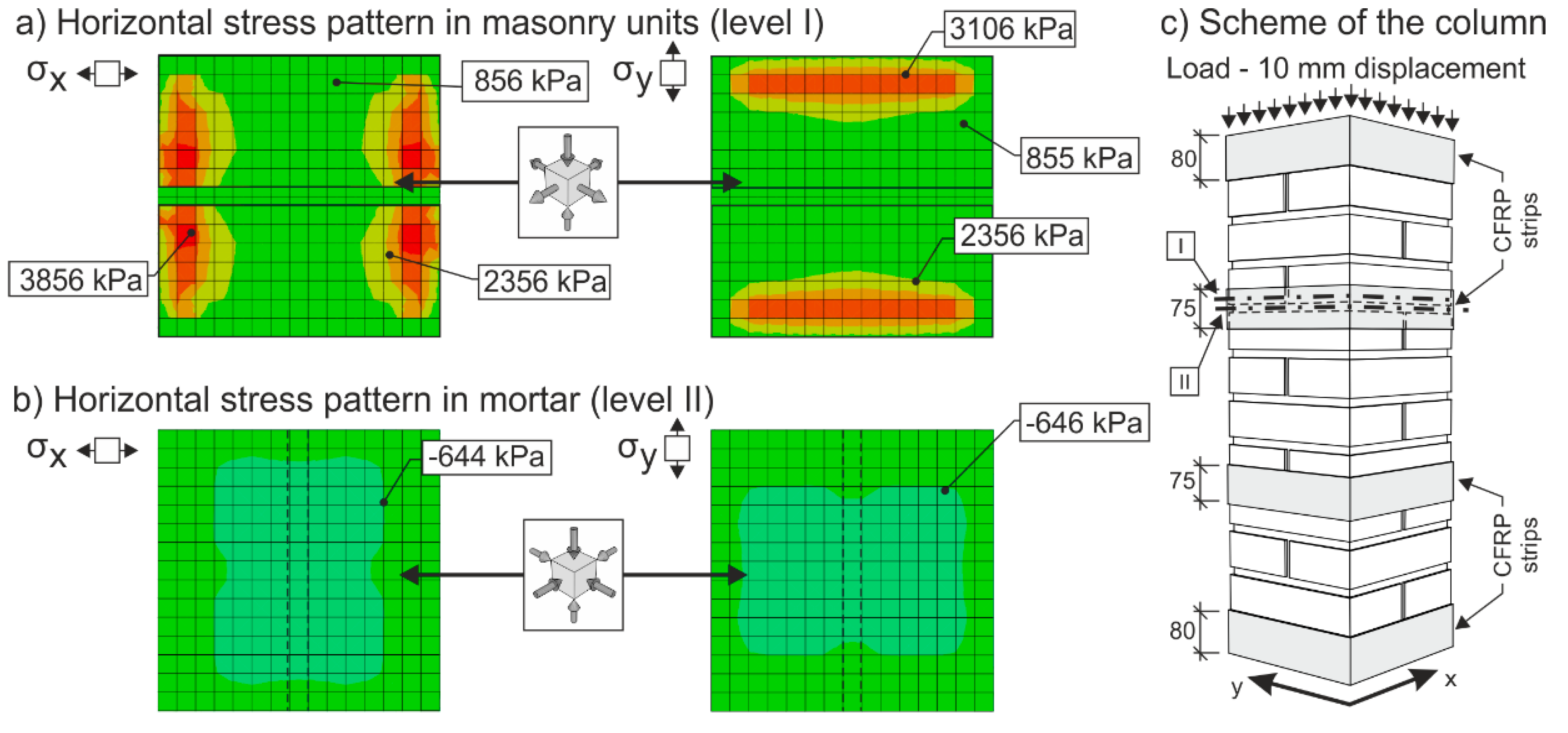
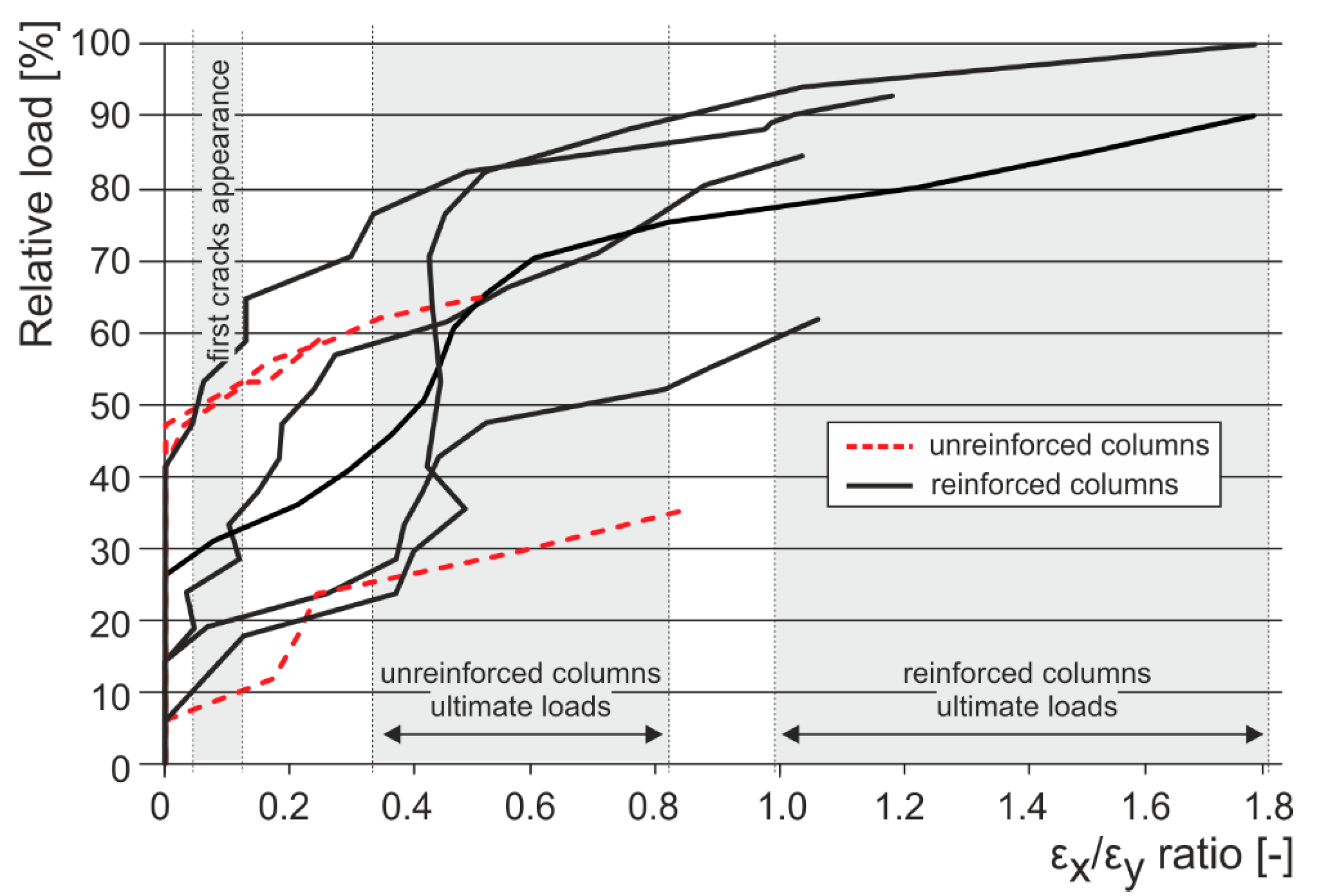

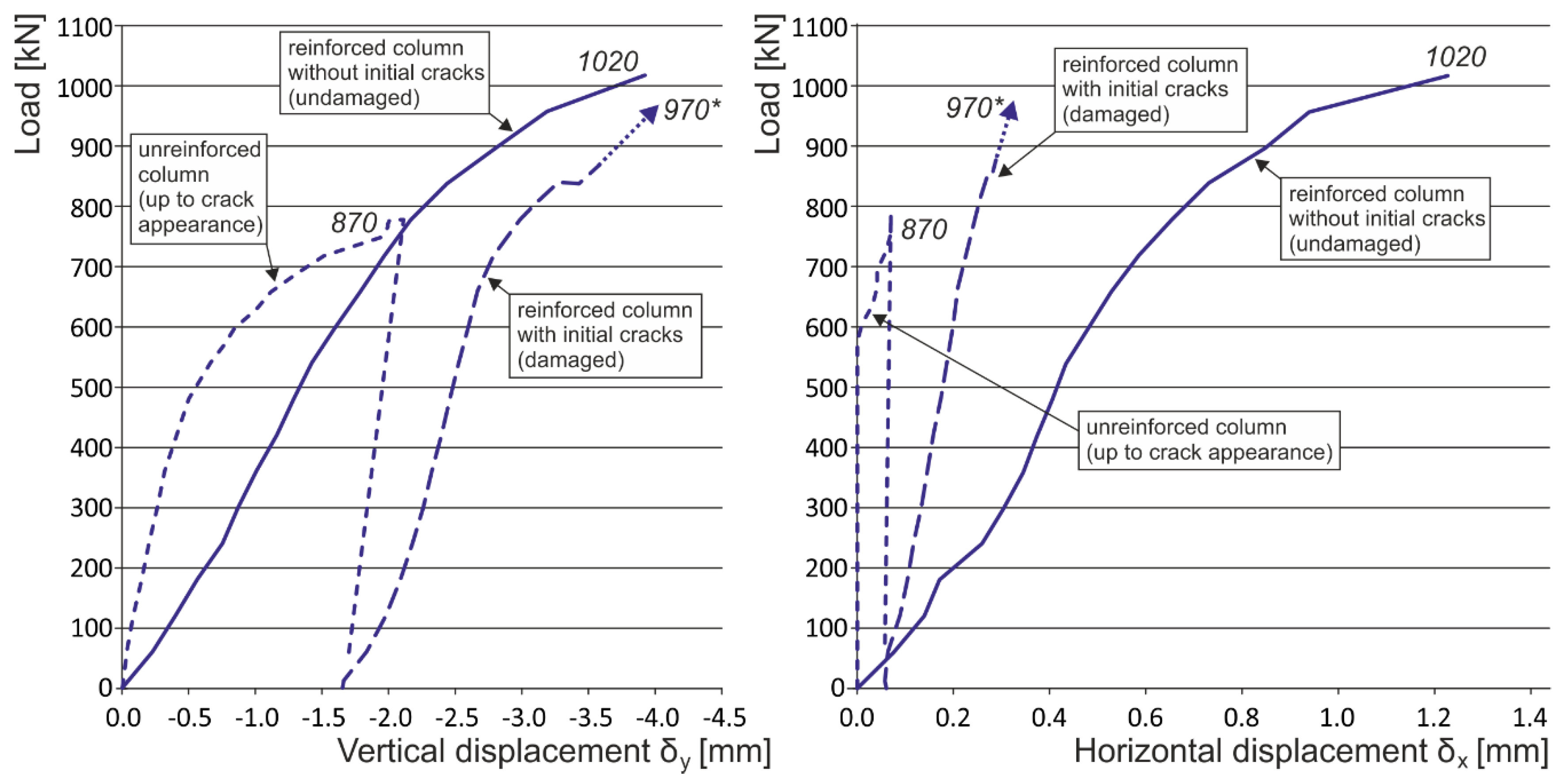
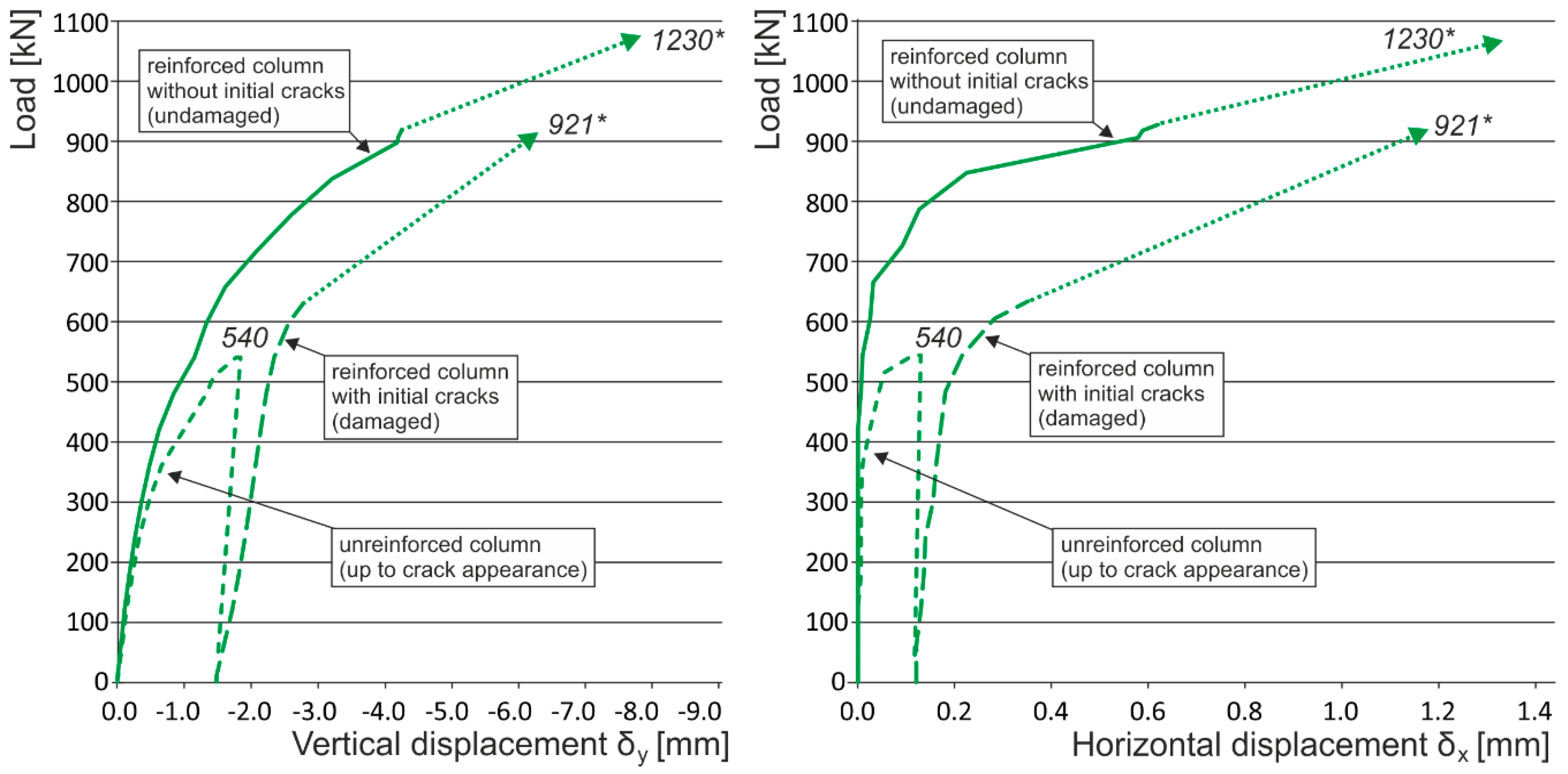

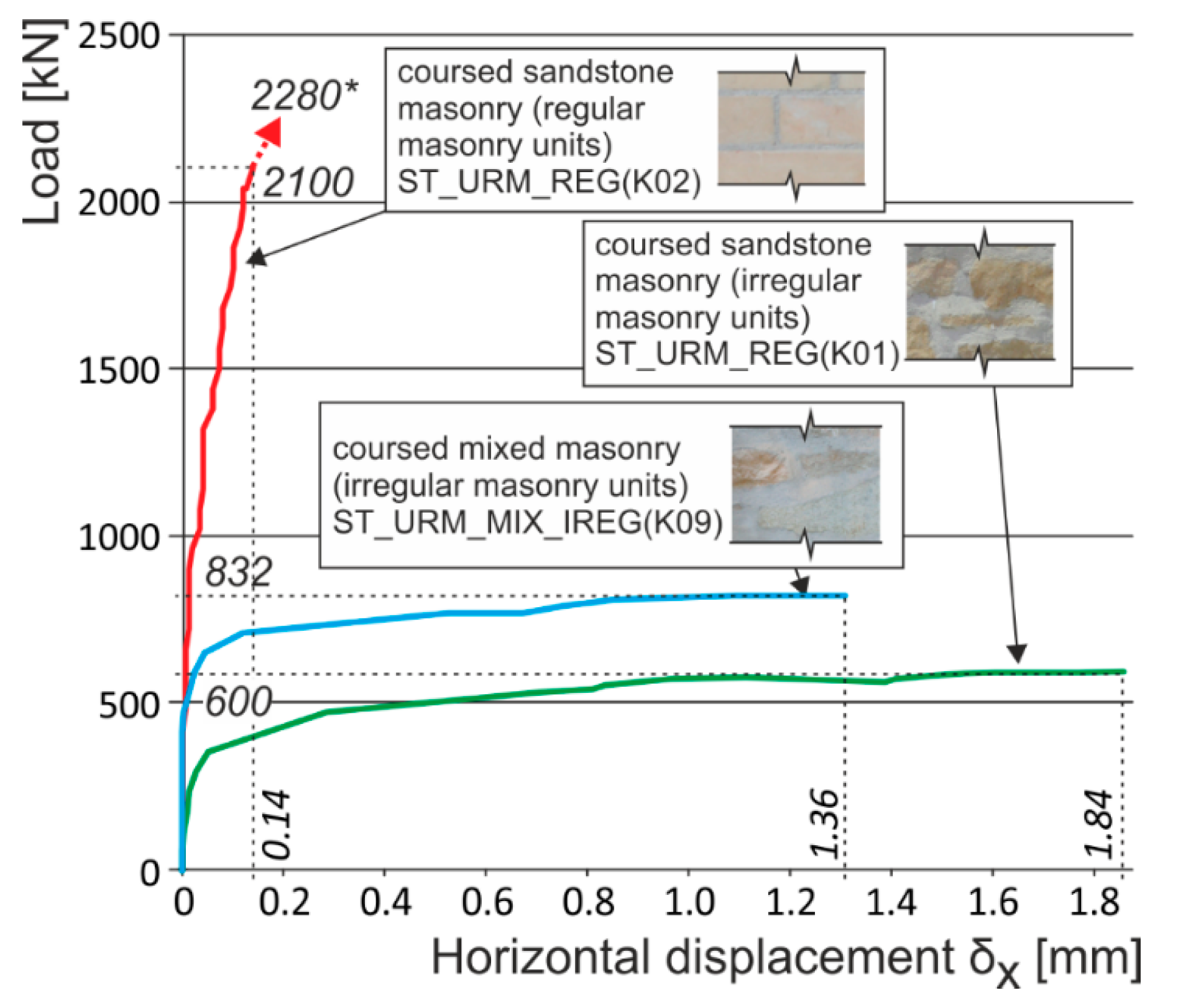
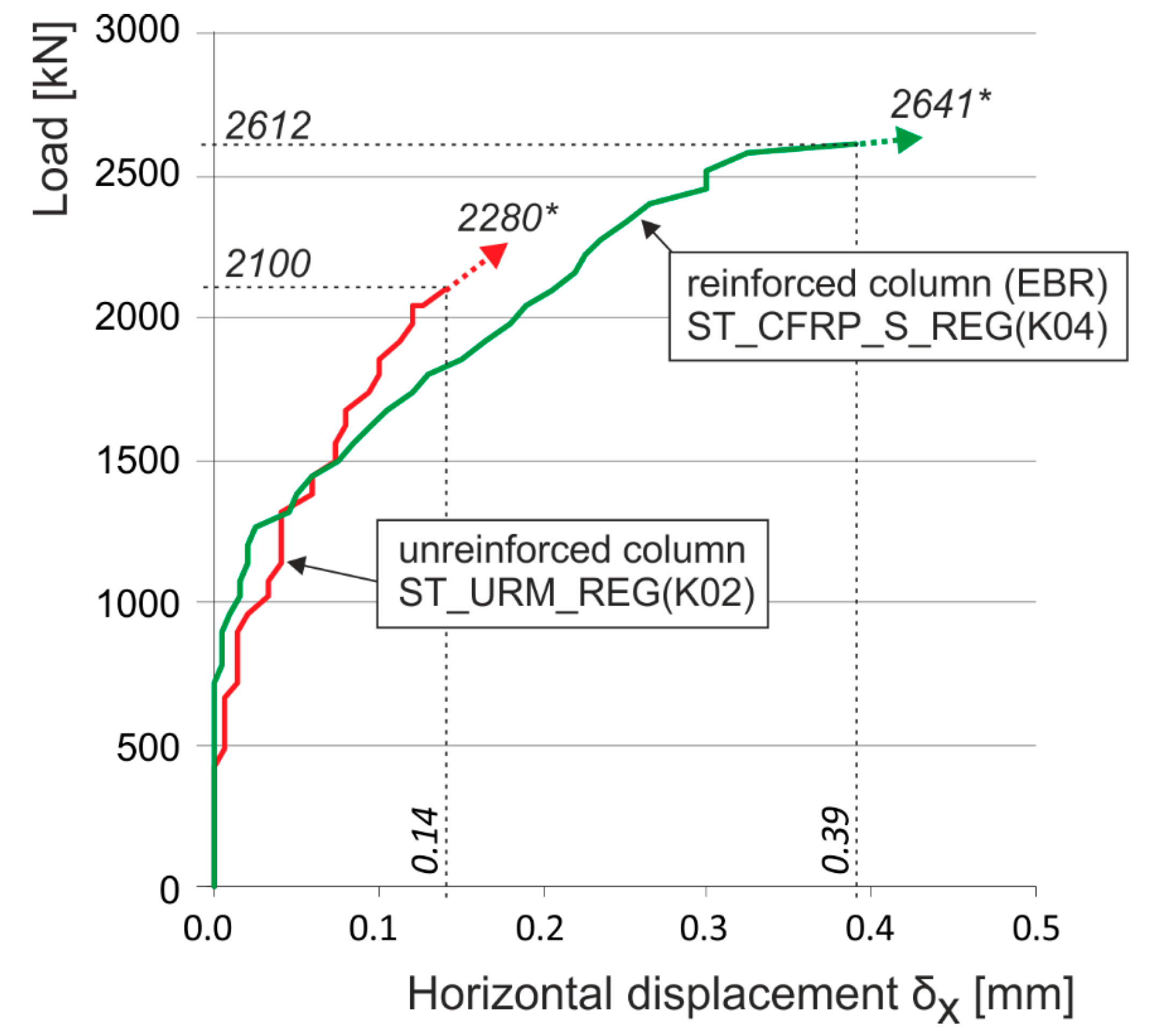
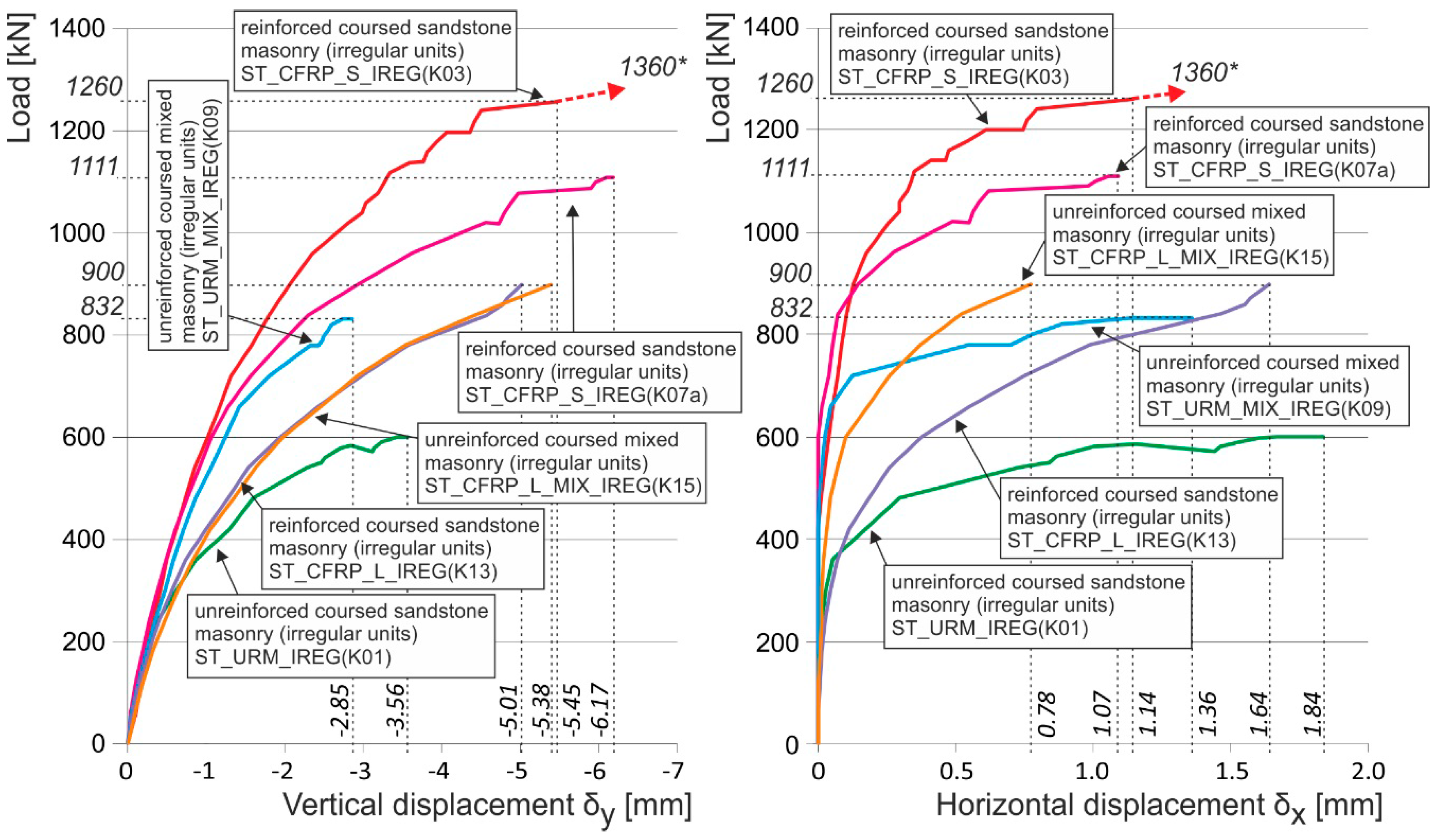
| Label | Dimensions [mm] | fb 1 [MPa] | fm 2 [MPa] | fk 3 [MPa] | Reinforcement |
|---|---|---|---|---|---|
| CB_URM(02) | 290 × 290 × 1020 | 15.0 4 | 2.0 4 | 4.51 | Unreinforced (URM) |
| CB_CFRP_S(11) | CFRP strips on surface (EBR) | ||||
| CB_URM(51a) | Unreinforced (URM), loaded up to first crack | ||||
| CB_CFRP_W(51b) | CFRP overall wrapping with initial cracks | ||||
| CB_URM(54a) | 290 × 290 × 920 | Unreinforced (URM), loaded up to first crack | |||
| CB_CFRP_S(54b) | CFRP strips on surface (EBR) with cracks | ||||
| CB_CFRP_L(56) | CFRP strips in grooves (NSM), every bed joint | ||||
| CB_URM(57) | 17.28 | 1.5 4 | 4.57 | Unreinforced (URM) | |
| CB_CFRP_W(58) | 17.03 | 1.96 | 4.9 | CFRP overall wrapping | |
| CB_CFRP_S_R20(61) | 286 × 286 × 870 | 11.60 | 1.88 | 3.70 | CFRP strips on surface (EBR), column corner radius 20 mm |
| CB_CFRP_S_R35(62) | 1.79 | 3.64 | CFRP strips on surface (EBR), column corner radius 35 mm | ||
| CB_CFRP_S_R50(63) | 1.84 | 3.67 | CFRP strips on surface (EBR), column corner radius 50 mm | ||
| CB_CFRP_W_R50(64) | 1.84 | 3.67 | CFRP overall wrapping, column corner radius 50 mm | ||
| CB_CFRP_S_R85(65) | 1.59 | 3.51 | CFRP strips on surface (EBR), column corner radius 85 mm | ||
| CB_CFRP_L_J3(66) | 290 × 290 × 890 | 11.60 | 1.23 | 3.25 | CFRP strips in grooves (NSM), every 3rd bed joint |
| CB_CFRP_L_J2(67) | 3.25 | CFRP strips in grooves (NSM), every 2nd bed joint | |||
| CB_CFRCM_W(68) | 1.5 4 | 3.45 | CFRCM overall wrapping | ||
| CB_URM(69) | 2.24 | 3.89 | Unreinforced (URM) | ||
| CB_CFRP_S_H75_1/3(70) | 288 × 288 × 875 | 1.75 | 3.62 | CFRP strips on surface (EBR), 75 mm at 1/3 | |
| CB_CFRP_S_H150_1/2(71) | 1.68 | 3.57 | CFRP strips on surface (EBR), 150 mm at 1/2 | ||
| CB_CFRP_S_H75_1/2(72) | 1.53 | 3.47 | CFRP strips on surface (EBR), 75 mm at 1/2 | ||
| CB_CFRCM_S(73) | 1.5 4 | 3.46 | CFRCM strips on surface (EBR) | ||
| CB_CFRP_S_R65(A02) | 286 × 286 × 890 | 2.08 | 3.81 | CFRP strips on surface (EBR), column corner radius 65 mm | |
| CB_CFRP_S_R85(A03) | 3.81 | CFRP strips on surface (EBR), column corner radius 85 mm |
| Label | Dimensions [mm] | fb 1 [MPa] | fm 2 [MPa] | fk 3 [MPa] | Reinforcement |
|---|---|---|---|---|---|
| ST_URM_IREG(K01) | 530 × 530 × 1750 | 22.73 | 2.0 4 | 1.99 5 | Unreinforced (URM), coursed sandstone masonry (irregular units) |
| ST_URM_REG(K02) | 545 × 545 × 1770 | 19.93 | 4.20 | Unreinforced (URM), coursed sandstone masonry (regular units) | |
| ST_CFRP_S_IREG(K03) | 550 × 560 × 1735 | 22.73 | 1.99 5 | CFRP strips on surface (EBR), coursed sandstone masonry (irregular units) | |
| ST_CFRP_S_REG(K04) | 548 × 545 × 1760 | 19.93 | 4.20 | CFRP strips on surface (EBR), coursed sandstone masonry (regular units) | |
| ST_CFRP_S_IREG(K07a) | 550 × 560 × 1735 | 19.51 | 3.03 | 0.94 5 | CFRP strips on surface (EBR), coursed sandstone masonry (irregular units) |
| ST_URM_MIX_IREG(K09) | 550 × 560 × 1735 | 20.82 | 2.14 | 1.92 5 | Unreinforced (URM), coursed mixed (sandstone, marlstone) masonry (irregular units) |
| ST_CFRP_L_IREG(K13) | 550 × 560 × 1730 | 19.51 | 2.25 | 0.86 5 | CFRP strips in grooves (NSM), coursed sandstone masonry (irregular units) |
| ST_CFRP_L_MIX_IREG(K15) | 550 × 550 × 1730 | 22.84 | 1.29 | 1.93 5 | CFRP strips in grooves (NSM), coursed sandstone masonry (irregular units) |
| Material characteristic | Dry fibers | Epoxy resin | Composite properties |
|---|---|---|---|
| Ultimate Tensile Strength in Primary Fiber Direction (MPa) | 3790 | 72.4 | 986 |
| Tensile Modulus (GPa) | 230 | 3.18 | 95.8 |
| Elongation at Break (%) | 1.7 | 5.0 | 1.0 |
| Ultimate Tensile Strength Normalized by Thickness (MPa/mm) | – | – | 986 |
| Tensile Modulus Normalized by Thickness (GPa/mm) | – | – | 95.8 |
| Nominal Laminate Thickness (mm) | – | – | 1.0 |
| Flexural Strength (MPa) | – | 123.4 | 123.4 |
| Flexural Modulus (GPa) | – | 3.12 | 3.12 |
| Material characteristic | Dry fibers | Cement matrix |
|---|---|---|
| Ultimate Tensile Strength in Primary Fiber Direction (MPa) | 4800 | 8.6 1 |
| Ultimate Compressive Strength (MPa) | – | 25.56 1 |
| Tensile Modulus (GPa) | 240 | – |
| Elongation at Break (%) | 1.8 | – |
| Density (g/cm3) | 1.78 | – |
| Thickness (mm) | 0.047 | – |
| Label | Ultimate vertical displacement 1 [mm] | Ultimate horizontal displacement 1 [mm] | Ntheor 4 [kN] | Nexp [kN] | Nexp/Ntheor |
|---|---|---|---|---|---|
| CB_URM(02) | 2.0 | 0.11 | 341.4 | 660 | 1.93 |
| CB_CFRP_S(11) | 3.93 | 1.23 | 634.6 | 1,020 | 1.61 |
| CB_URM(51a) 2 | – 2 | – 2 | – 3 | 540 2 | – 3 |
| CB_CFRP_W(51b) | 1.29 | 0.22 | 727.3 | 921 | 1.27 |
| CB_URM(54a) 2 | – 2 | – 2 | – 3 | 780 2 | – 3 |
| CB_CFRP_S(54b) | 1.93 | 0.23 | 718.5 | 970 | 1.35 |
| CB_CFRP_L(56) | 5.08 | 0.42 | – 3 | 831 | – 3 |
| CB_URM(57) | 2.76 | 1.16 | 313.0 | 480 | 1.54 |
| CB_CFRP_W(58) | 4.26 | 0.62 | 803.5 | 1230 | 1.53 |
| CB_CFRP_S_R20(61) | 10.76 | 1.07 | 488.3 | 720 | 1.48 |
| CB_CFRP_S_R35(62) | 5.97 | 0.68 | 497.6 | 870 | 1.75 |
| CB_CFRP_S_R50(63) | 8.21 | 0.34 | 509.2 | 950 | 1.87 |
| CB_CFRP_W_R50(64) | 11.46 | 3.06 | 680.6 | 1200 | 1.76 |
| CB_CFRP_S_R85(65) | 7.76 | 0.56 | 489.7 | 820 | 1.67 |
| CB_CFRP_L_J3(66) | 3.46 | 0.42 | – 3 | 650 | – 3 |
| CB_CFRP_L_J2(67) | 3.77 | 0.11 | – 3 | 660 | – 3 |
| CB_CFRCM_W(68) | 4.09 | 1.02 | – 3 | 680 | – 3 |
| CB_URM(69) | 3.18 | 0.1 | 269.9 | 660 | 2.45 |
| CB_CFRP_S_H75_1/3(70) | 4.39 | 0.43 | 367.5 | 839 | 2.29 |
| CB_CFRP_S_H150_1/2(71) | 4.91 | 0.05 | 378.4 | 720 | 1.90 |
| CB_CFRP_S_H75_1/2(72) | 6.31 | 1.16 | 301.2 | 690 | 2.29 |
| CB_CFRCM_S(73) | 5.52 | 0.83 | – 3 | 678 | – 3 |
| CB_CFRP_S_R65(A02) | 4.82 | 0.85 | 528.2 | 1061 | 2.01 |
| CB_CFRP_S_R85(A03) | 5.60 | 0.15 | 522.9 | 950 | 1.82 |
| Label | Ultimate vertical displacement 1 [mm] | Ultimate horizontal displacement 1 [mm] | Ntheor 2 [kN] | Nexp [kN] | Nexp/Ntheor |
|---|---|---|---|---|---|
| ST_URM_IREG(K01) | 3.56 | 1.83 | 505.2 | 600 | 1.19 |
| ST_URM_REG(K02) | 3.42 | 0.22 | 1122.8 | 2280 | 2.03 |
| ST_CFRP_S_IREG(K03) | 5.45 | 1.14 | 1073.7 | 1360 | 1.27 |
| ST_CFRP_S_REG(K04) | 3.59 | 0.39 | 1899.0 | 2641 | 1.39 |
| ST_CFRP_S_IREG(K07a) | 6.17 | 1.09 | 600.0 | 1111 | 1.85 |
| ST_URM_MIX_IREG(K09) | 2.83 | 1.36 | 532.7 | 832 | 1.56 |
| ST_CFRP_L_IREG(K13) | 5.01 | 1.64 | 237.7 | 900 | 3.78 |
| ST_CFRP_L_MIX_IREG(K15) | 5.38 | 0.78 | 524.5 | 900 | 1.72 |
© 2016 by the authors. Licensee MDPI, Basel, Switzerland. This article is an open access article distributed under the terms and conditions of the Creative Commons Attribution (CC-BY) license ( http://creativecommons.org/licenses/by/4.0/).
Share and Cite
Witzany, J.; Zigler, R. Stress State Analysis and Failure Mechanisms of Masonry Columns Reinforced with FRP under Concentric Compressive Load. Polymers 2016, 8, 176. https://doi.org/10.3390/polym8050176
Witzany J, Zigler R. Stress State Analysis and Failure Mechanisms of Masonry Columns Reinforced with FRP under Concentric Compressive Load. Polymers. 2016; 8(5):176. https://doi.org/10.3390/polym8050176
Chicago/Turabian StyleWitzany, Jiří, and Radek Zigler. 2016. "Stress State Analysis and Failure Mechanisms of Masonry Columns Reinforced with FRP under Concentric Compressive Load" Polymers 8, no. 5: 176. https://doi.org/10.3390/polym8050176
APA StyleWitzany, J., & Zigler, R. (2016). Stress State Analysis and Failure Mechanisms of Masonry Columns Reinforced with FRP under Concentric Compressive Load. Polymers, 8(5), 176. https://doi.org/10.3390/polym8050176





